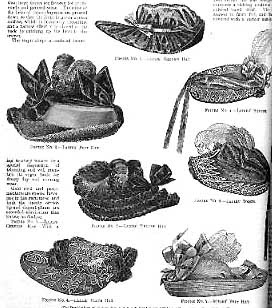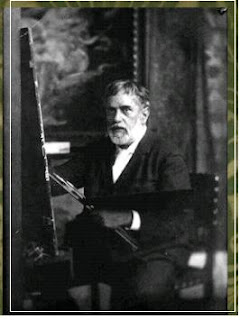Sunday, March 18, 2007
Dress at The Turn of the 20th Century
Women's dress in the 1890's continued to be built in a sturdy, heavy, upholstered style, but the silhouette changed to that of an hour glass. Female bodies were corseted to a small waist, and then padded in the buttocks, hips, bosom and sleeves to exaggerate the apparent wasp-waisted effect.
Hats began to grow larger in the 1890's, a trend that continued steadily until 1911.
Men's Dress in the 1890's took a turn towards greater formality and dandyism in Europe, and went in the opposite direction in the U.S. where the popular mode was brightly colored sportswear.
American men of around 1900 tried to emulate the image of the "Arrow Shirt Man" drawn by J.C.Leyendecker, with brightly colored shirts and hard white tubular collars worn under the sporty Sack Suit jackets, that had recently moved up from sport clothes to business wear. During this period in the US, the European fashion for Frock coats like the Prince Albert Coat and the Cutaway is gradually displaced by the sack, so much so that even rich American men sport an evening version of the sack, the Tuxedo, to male only parties and semi formal events.
Most women's dress in this era was highly influenced by the advancing feminist cause, which after 1903 escalated to widespread civil disobedience by "Suffragettes" (radical suffragists). Women modeled their behavior and appearance upon the Gibson Girl the popular image of the "New Woman". Men's clothing styles such as the suit, shirt, hard collar and tie were worn by women forcing themselves into professions formerly occupied by men. Health fads of the 1890's and 1900's also encouraged women's sporting activities, particularly bicycling, which, in turn promoted sport clothing as a fashion.
Dress reform, continued to be a hot topic in this period, even gaining such notable adherents as Mark Twain.
Artists such as Mariano Fortuny in Italy and the Wiener Werkstaette group in Austria continued to design Aesthetic reform costumes such as Fortuny's Delphos Dress, and dress became progressively more comfortable, practical and aesthetically pleasing in this whole era. The beauty of the designs worn in this era are so apparent that the period 1890-1914 is commonly called la Belle Époque ("The Beautiful Epoch")
Mario Fortuny
Women's clothing after 1900 became lighter and lighter in construction and materials. A popular style in this period was the "Lingerie Dress" a feather-light white cotton dress inset with strips of open work lace and net.
After 1908, women's dress became more vertical in line, and less "S" curved. The vertical line became so pronounced after 1910 that highly fashionable dresses tended to hobble the wearer. Corsets began to be replaced by brasseries and other light foundation garments
Wednesday, December 20, 2006
Victorian Clothing:The Dress in The First and Second Bustle Periods
The dress of the first bustle period (1870's) is noted for the lightness of it's material and decoration, swathing the lower reaches of a woman's body in numerous ruffles and pleats, often in light colors using the new and vibrant aniline dyes.
Late in this decade (1878-79) was the "Fishtail" style, where the lower part of the skirt was tight, and ended in a train.
The second bustle period (the 1880's) is heavier, with decoration more resembling upholstery style. Colors get more Jewel-toned and velvets, heavy satins and brocades replace the taffetas and cottons of the 1870's. Surface decoration is often of passementarie or jet beads, giving the whole ensemble a more mature flavor.
Men's Dress
Men's dress in this era continues in it's general dullness but begins to be enlivened with sportswear, an area that continues to provide the most intriguing variants of men's dress.
Dress during the 1870's and 1880's came more and more under the influence of the Rational Dress Movement and the Aesthetic Movement . Dress reform from artists, feminists and socialists provided a continuous counterpoint to the more frivolous dress of fashionable women, and the more tedious dress of fashionable men.
DRESS REFORM MOVEMENT 1850-1914
Dress reformers o f the Aesthetic movement such as Oscar Wilde promoted jewel-toned velvet suits with breeches for men, but only found a lasting audience among mothers who dressed small boys in "Little Lord Fauntleroy" suits in this style. Caricaturists such as George du Maurier simultaneously lampooned the Aesthetic dress even as they spread it's influence. The Gilbert and Sullivan opera Patience spread the Aesthetic style to America, with costumes from Liberty Co. where it was transformed in the following decades into the Arts and Crafts Movement. Women's aesthetic dress, with it's semi medieval lines and uncorseted waists were transformed by popular taste into the Teagown, a fashionable lady's at home garment.
Rational dress advocates like George Bernard Shaw tried to popularize Jaeger combination suits (which resembled woolen long johns), but were laughed off the streets. Dr Jaeger's more conservative ensembles of wool knickers and a Norfolk jacket however were accepted as men's sportswear even among the fashionable.
Tuesday, December 12, 2006
Victorian Clothing:The "Romantic" Period
Clothing from 1825-1850
The trend towards sexual dimorphism in dress reaches an absurd apex in this period. Men's fashion becomes a series of undecorated black tubes, like the smoke stacks of the The Industrial Revolution (an analogy they were even conscious of at the time), while women's dress continues to balloon out with ruffles, decorations and petticoats until women look like ambulatory wedding cakes.
Both men's and women's dress becomes more complex during this era due to the invention of the Sewing Machine, and the popular dissemination of pattern books and systems for garment cutting. Men's clothing construction, while outwardly simple, begins to acquire the internal padding, interfacings and complex structure that makes modern men's suits fall so smoothly even over an object as lumpy and mobile as the human form.
Elias Howe, the inventor of the first mass produced, practical sewing machine, originally demonstrated it's utility to a group of prospective investors by holding a sewing race between himself and his machine, and ten professional hand stitchers. He easily won, and the economic situation of stitchers (mostly female) declined as a consequence of the adoption of the invention. With a sewing machine, a stitcher could produce ten times the output as before, with greater quality, but the stitcher rarely could afford the machine, and with so many stitchers out of work, stitchers were easily replaceable. Industrialists would invest in the machines, hire the stitchers cheaply, and then swallow the profits that their increased output produced. With profits so high, soon competition between manufacturers of clothes got fierce, and so producers tried to "improve" their product by adding more sewing decoration, such as ruffles, pleats, and top stitching, to lure customers. The end result was that fashionable Women's dress became incredibly over decorated in the 19th Century.
Another result of this increased output in clothing manufacture was that poor people's clothing got better, and the rags of earlier eras were replaced by cheaply made mass manufactured work clothes. The middle classes were able to afford more than clean simple clothes, and began to actively indulge in fashion for it's own sake.
"The Last of England" by Ford Maddox Brown, showing the dress of poor English people as they emigrate to Australia.
Fashionable women's dress grew more and more cumbersome and impractical during the 1830's and 1840's. The visual line of 1840's gowns, hats and headdress all point down, and the eyes of women depicted in fashion plates are demurely cast to the floor. The increasing size of the skirts, held out only with voluminous and usually unsanitary crinoline (horsehair canvas) petticoats, made the weight of the skirts oppressive, and movement awkward. Tight laced Corsets of a waist-cinching style, pinched the waist without providing the back supporting properties of corsets of other eras.
This is the time of the tortured and victimized Bronte heroines, not to mention the tortured and victimized Bronte Sisters themselves. The 1840's proved such a low point for women in Western history, that the worm finally turned, and women began to organize and agitate for the vote, dress reform, and the right to enter schools and professions closed to them.







